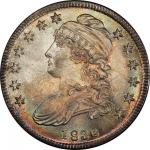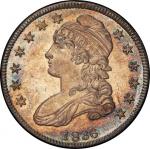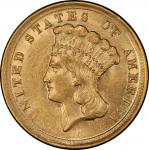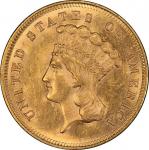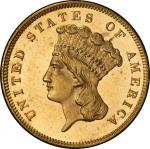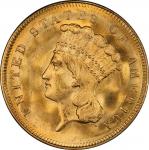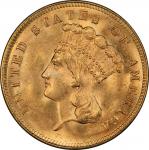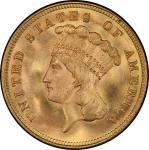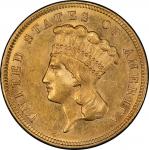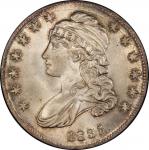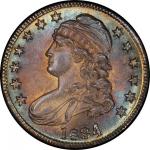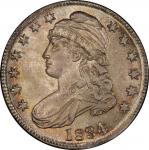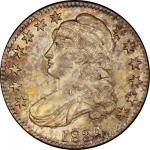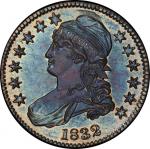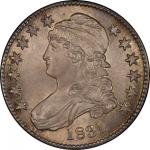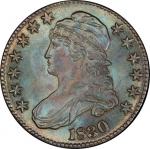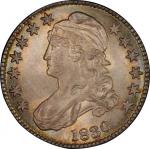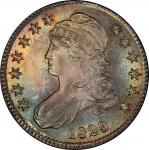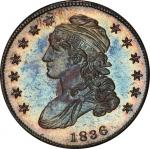“Brilliant proof. A magnificent piece in every way. ... Excessively rare in this preservation.” — Henry Chapman, 1907 Among the most spectacular of all early Proof coins in the D. Brent Pogue Collection, this 1836 half dollar has been the object of extraordinary care, receiving special preparation at the time of its manufacture and especial care ever since. In the nearly two centuries since it was caught as it fell from the dies, it has grown more beautiful. Its splendid mirrors have remained intact as its toning has bloomed. After years of natural maturation, its surfaces now show exceptional tones of bright blue and violet at centers, and gold and warm rose inside the rims. The reverse coloring is particularly bright, its blue verging on cobalt. The depth of the reflectivity and the sharpness of the devices evoke the finest Proof productions of the Philadelphia Mint. The central devices show sharpness that asymptotically approach full realization of detail. Every die finish line on Liberty’s bosom, every graver stroke on her cap, all the fine definition on her curly hair and all the contours of the eagle’s feathers: each is present and fully struck. The only localized softness is found at the center of star 7 and the lowest olive leaf on the reverse, which lines up in opposition to star 7. The delicate lapping lines between Liberty’s chin and the top of her chest are visible, as are single die finish lines elsewhere, including one from the top arrow through ICA of AMERICA. The surfaces have been handled with the utmost delicacy. A few tiny lintmarks were left at the moment of coining, including one in the field parallel to the bridge of Liberty’s nose and another above the C in the denomination. The only contact marks are found at the tip of Liberty’s bust, where one tiny nick is hidden in the drapery and another hugs the end of a single denticle. A few sparse hairlines run vertically in the small field near the tip of Liberty’s cap and horizontally near star 12. Other hairlines are wispy and trivial, found in the fields and on Liberty’s cheek. Proof 1836 lettered edge half dollars are known from a number of different die pairs. None are common, and few of the survivors of any die combinations are gems. The 1836 Overton-116, known for its 50/00 punching error on the reverse, may be the most numerous, with either five or six specimens known. Nearly as many Proof examples of 1836 Overton-108, the 1836/1336 variety, have survived. The only 1836 Overton-101 with claims to Proof status to have sold in recent memory is the Eliasberg coin; PCGS has never certified a Proof of that die combination, however. The National Numismatic Collection contains a little publicized Proof 1836 Overton-107 that is thought to be unique. We have located three Proof examples of 1836 Overton-109: 1. J. Colvin Randall - T. Harrison Garrett - Garrett I:328 - Superior’s Chalkley sale (January 1990):3551 - Douglas Noblet - Bowers and Merena’s sale of January 1999:1135 - Superior’s sale of February 2001:5534. Last sold as Proof-65 (NGC). 2. Mrs. Emery May Norweb - Norweb I:3114 - Bowers and Merena’s sale of August 1996:130 - Heritage’s sale of April 2013:4269. Last sold as Proof-64 (NGC). 3. This coin. The finest known. A possible fourth example was sold as lot 374 in the January 1993 “Bullet sale” by Heritage, but the description provided in the unillustrated sale catalog precludes confirmation. Graded Proof-64 by PCGS, the coin was described as “brilliant;” at the time, it was the only Proof 1836 lettered edge half dollar certified by PCGS. Though superb provenance accompanies each of the three confirmed Proof specimens from these dies, few American numismatic cabinets are more legendary, or more ancient, than Matthew Adams Stickney’s. Stickney is the earliest American collector who built a substantial cabinet that survived intact late enough that its contents were well-cataloged, and its highlights photographed, before its dispersal. Though sold in a 1907 auction by Henry Chapman, Stickney’s collection was mostly built in the 1830s through 1850s. After his only older brother, Dudley Stickney, Jr., passed away as a young man in 1829, Matthew was the sole heir of the estate of his father, Dudley Stickney, Sr., a successful merchant who died in 1834. Armed with a new fortune, in addition to the fruits of his own labors, Stickney retired from the grocery business and primarily devoted his time to numismatics. Within a few years, he was “known up and down the East Coast as the go-to man for coins, whether they be rare or simply bullion,” according to a biography by researcher Charles Davis. In the 1850 United States census, his occupation was listed as “trader,” an indication that Stickney not only collected, but swapped and sold coins to acquire new rarities for his cabinet. After that time, his primary pursuits were genealogical and historical research. The August 1894 record of his death kept by the state of Massachusetts listed his occupation as “historian.” His interest in coins waned about 1854, according to a letter Stickney sent Ed Cogan in June 1867, “when, in consequence of ill health, I gave up my business, and ceased to make active efforts for additions to my cabinet, only obtaining the regular series of Proof coins from the Mint, which I have received from them for twenty five years,” The introduction to the 1907 Stickney auction catalog assured bidders that nothing had been removed or sold since Stickney’s death in 1894, and the contents of that catalog show that he owned nearly everything a collector of American coins could desire: an 1804 dollar, a Brasher doubloon, superb United States Mint issues and even better colonial coins. The selection of English and other world coins was rich, though he evidently never had a serious interest in American medals or paper money. The post-1854 issues in his cabinet show that he enjoyed a close relationship to the Mint. The Stickney Collection was full of rare patterns dated as late as 1885, Proof sets and single coins through the 1880s “as brilliant and bright as the day they left the Mint, having never been out of the possession of Mr. Stickney, who bought them at the Mint,” as well as sets of circulation-strike coins through 1875 that had “never been disturbed since they were selected at the Mint.” The early date that Stickney began collecting, as well as his connection to the United States Mint, are enough to inspire the question of whether this Proof 1836 half dollar may have been acquired directly from the Mint. A letter discovered by Charles Davis sheds light on the close relationship between Stickney and Mint assayer, and keeper of the Mint Cabinet, William DuBois. Written on July 12, 1843, the DuBois letter inventories a group of coins sent from the Mint to Stickney for his collection. “I have sealed up a box of specimen coins,” William DuBois wrote, listing one of each denomination of coins struck in 1843, which he further described as “chiefly master coins,” using the then-current term for Proof coinage. The list also included Stickney’s Class I 1804 dollar, long described as the fruit of a trade for a gold striking of the 1785 Immune Columbia copper, but actually a duplicate extracted from the Mint Cabinet by DuBois for his friend Mr. Stickney. DuBois did ask for something in return: “for my pains in this matter, you will be willing to spare a few pieces of your Roman coins, which I want for myself,” in addition to a payment equal to the face value of the coins, $6.75, payable to the Mint. Stickney’s 1843 Proof set was sold as lot 1787 in the 1907 Stickney sale, the earliest of a substantial run of similar sets. This 1836 Proof half dollar was the only 1836-dated Proof in the sale, other than issues sold as patterns, precluding the possibility that Stickney once had an entire 1836 Proof set but leaving open the speculation that this coin may have been traded out of the Mint cabinet. The technological stature of American coins took an enormous leap forward in 1836. Lettered edges had long since been eliminated from other denominations, but the edges and the laborious two-step process required to create them continued on half dollars until this issue. With the introduction of the steam press in 1836, used in conjunction with a close collar that could create edge reeding at the moment of striking, the days were numbered for this design type. This coin and others of this emission represent the last in a four-decade tradition of lettered-edge half dollars. The edge lettering on this piece is bold, but shows some of the pitfalls of the practice, including visible overlapping of the designs struck by two separate edge dies, seen beneath the date. When cataloging this coin in 1907, Henry Chapman was seemingly aware of the existence of crushed lettered edges on Proof half dollars of this era when he noted that on this coin, the “Edge lettering [is] perfect.” This is the finest Proof half dollar of this date ever certified. Only two other Proof Capped Bust half dollars have ever been graded Proof-66 or finer by PCGS, both dated 1827. Represented by three separate submissions, one is graded Proof-66 CAM (and Proof-66) while the other piece, graded Proof-68, is the only example of this type ever graded finer than the Stickney-Pogue 1836 Overton-109. Henry Chapman called this coin “magnificent … in every way” in the 1907 Stickney sale. More than a century later, his phrasing is, like this coin, essentially perfect. PCGS# 147881. NGC ID: 24GG.

